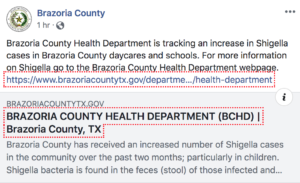All fields are required
Posted in Our Blog,Outbreaks & Recalls,Shigella on November 27, 2019

Brazoria County announced today that it has has received an increased number of Shigella cases in the Texas county over the past two months. Most of these cases are in children. The number of cases and exact daycares have not been publicly announced in this Brazoria County Daycare Shigella Outbreak.

Shigellosis is a Texas Notifiable Condition and should be reported within one week to the Brazoria County Health Department staff; phone numbers 979-864-2154 or 979-864-2168.
Shigella is a bacteria. Shigella infections are responsible for 300,000 illnesses and 600 deaths per year in the United States. The hospitalization rate associated with Shigella is also very high with an estimated 62,000 hospitalizations per year.
Shigella’s main victims are children, HIV patients, and those with weakened immune systems. Small children are not able to maintain proper hygiene. This is the main reason why Shigella is so common among children.
Another major reason why Shigella is so common among children is because they are not yet immune to S.Sonnei.
The best way to find out if you have Shigella is to see your physician and obtain a stool test. Symptoms of a Shigella infection include:
Some individuals, when infected with Shigella bacteria, may not show any signs or symptoms of the infection. The bacteria, however, will continue to live in their intestinal tract until the body’s immune system has completely destroyed it.
Those who are infected and show symptoms will do so within one to three days after ingesting infected food or drink. Usually, healthy adults will recover within five days to a week. But those who are in the high risk group may have longer, more severe infections.
If you are exhibiting any of the symptoms mentioned above, medical attention is recommended. Shigella infections may have long-term complications. Early medical attention may help reduce the likelihood of complication.
Most of the Shigella outbreaks are also associated with places that have more children like daycare centers, nursing homes, etc. Some other most common settings for Shigellosis outbreaks are institutional settings (like prison) or cruise ships. In fact, Shigella is responsible for 16% of all the cruise ship outbreaks. Shigella spreads when you come in contact with the contaminated feces. Of these, 80% of all cases of Shigella are as a result of person to person infection.
Yes. Children less than 2 years old who have suffered from an infection do have chances of developing a severe infection accompanied by a fever that might turn into a seizure.
Shigella is one of the most communicable type of bacterial diarrhea that exists. No person is immune to Shigellosis. Considering the nastiness of the virus, there is an ongoing research for development of Shigella vaccine. Since children are a major victim of this virus, most of the cases of Shigella will automatically go down once the vaccine is injected.
Shigella can spread by a relatively tiny dose of infection (less than 100 bacteria are required to catch the disease). That is a very tiny amount of bacteria, which is why it is so easy for Shigella to transfer from person to person.
Another reason why Shigella is so dangerous because the bacteria thrives easily in the intestine of humans, which makes it so easy to transfer both from person to person and contamination of food, water, etc.
Shigella is spread through fecal-oral route. It is highly contagious, which means just a small amount of germs are enough to make someone sick. People shed Shigella in their stool when they are infected and up to a week or two after their symptoms are gone. You can get Shigella bacteria by:
Foods that are most commonly associated with this pathogen are salads and sandwiches that are handled a great deal in their preparation, and raw vegetables contaminated in the field.
Additionally, Shigella can proliferate on unclean utensils, plates, and cups. Shigella is also known to be found in developing countries without proper drinking water treatment facilities.
The treatment of Shigella can depend on how strongly the symptoms have developed. If the symptoms are mild, then the doctor generally do not prescribe any medicines and let immunity do its work. The patient is advised to rest and take plenty of fluids. In other cases antibiotics such as cefixime, ampicillin or trimethoprim are prescribed. Due to growing antibiotic resistance, the choices of treatment are limiting over time. It is best that we take good care of our hygiene and wish for Shigella vaccine to develop in order to avert the antibiotic resistance crisis.
Our mission is to help families who have been harmed by contaminated food or water. When corporations cause Shigella food poisoning outbreaks or Legionnaires’ disease outbreaks, we use the law to hold them accountable. The Lange Law Firm is the only law firm in the nation solely focused on representing families in food poisoning lawsuits and Legionnaires disease lawsuits.
If you got sick with Shigella in this Brazoria County Daycare Shigella Outbreak and are interested in making a legal claim for compensation, we can help. Our Shigella Lawyer can help you pursue compensation for you or your child’s Shigella infection. Call us for a free no obligation legal consultation at (833) 330-3663 or send us an e-mail here.
By Candess Zona-Mendola, Editor (Non-Lawyer)